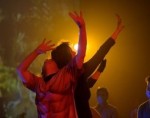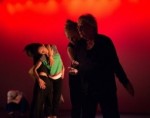
Photo: Susan Rethorst
Choreographic Thinking: Practical Philosophy for Dance
by Megan Bridge
A Choreographic Mind: Autobodygraphical Writings, a collection of essays and musings by Susan Rethorst, is written for philosophers. Now, when some people think about philosophy they may picture old dusty books and navel gazing, libraries full of overstuffed chairs and slanted shafts of light. But to remember the etymology of the word (philosopher = lover of wisdom) is to call up a much broader, more flexible, and contemporary group of thinkers that Rethorst’s book speaks to, about, and sometimes for. In her words, a choreographic mind is a mind that has “a kind of spatial emotional map of a situation, the emotional psychological reading of place, and of people in relation to that place and each other...” This is the philosophical realm of choreographers.
Rethorst witnesses a major trend in dance that privileges language and discourse. She tells specifically of watching student choreographers become totally derailed by language through discussing, describing, perhaps defending their work in the making. Teachers may encourage makers to strive for clarity of choreographic intention, but “The power of having declared a singular idea invests that idea with a demand for loyalty and follow-through.” Rich or complex choreographic images, full of multiplicity and potential, get buried under words, and get narrowed into a singular interpretation... "the singular preferred association becomes a kind of proxy for the original.” A Choreographic Mind calls for giving the body’s intelligence primacy; dance and choreography needn’t rely on analytic thought to ensure intellectual rigor. This doesn’t mean that we as choreographers shouldn’t speak articulately about our work, or that we shouldn’t read theory! Rather, Rethorst makes a case for allowing language to follow the creative process instead of lead it.
A Choreographic Mind returns regularly to, perhaps even revolves around, the concept of “affect” in bodies and movement. “Affect” is a bit of a
buzz-word at the moment in theoretical circles. A description of
The Affect Theory Reader (2010, Duke University Press) defines affect as “those visceral forces beneath, alongside, or generally
other than conscious knowing that can serve to drive us toward movement, thought, and ever-changing forms of relation.” A theorist I know describes affect as always asking the question (after Spinoza) “What can a body do?” With affect there is an openness to possibility that is pre-conceptual. Rethorst arrives at her use of the term independently of its use in theory.
Making dances, Rethorst told me in a recent interview, has brought her to metaphysics and theories of bodies and mind. When she looks at a dance, she sees that it effects a response, it acts on a viewer, it has its own agency. This is a dance’s “affect,” for Rethorst, and it is inherently bound up with a body’s knowledge, a physical “knowing” that comes before cognitive thought.
To elucidate this physical knowing, Rethorst offers up an example from every day life: crossing the street while a car is coming. In order to get across the street, an instant judgment (which takes into account many factors: How fast is the car going? Are you in the company of a child?) is made “...with hardly a dent in that busy brain buzz of ‘thought,’ or conversation with a walking companion.” We’ve made a somatic decision, we’ve used a form of thinking that we would never get to if we were stuck on the sidewalk calculating speed, velocity, and lines of force with our cognitive mind.
Rethorst claims that we not only ignore or downplay the significance of this physical thought in our everyday lives, but we even downplay the body’s knowledge in dance, where (you’d think) it should be leaping to the forefront. Rethorst’s book comprehensively articulates many of the tenets she has formulated through a pedagogical and choreographic practice that spans three continents and three decades. Offering up personal anecdotes, philosophical musings, and practical applications, A Choreographic Mind is the essential choreographer’s companion for the 21st century.
Rethorst will hold a book reading and signing in January 2013 at University of the Arts, details TBA.
By Megan Bridge
September 3, 2012











